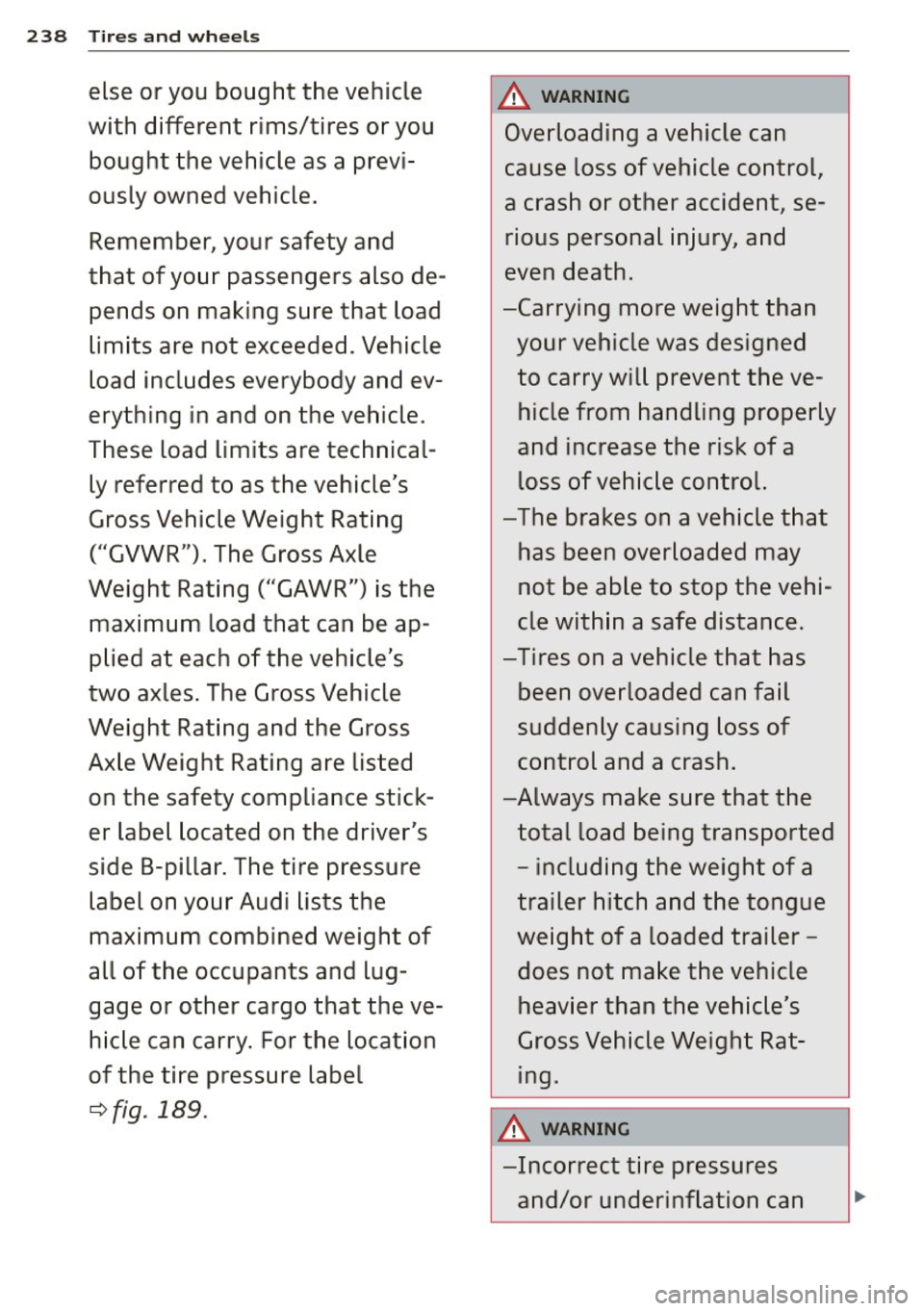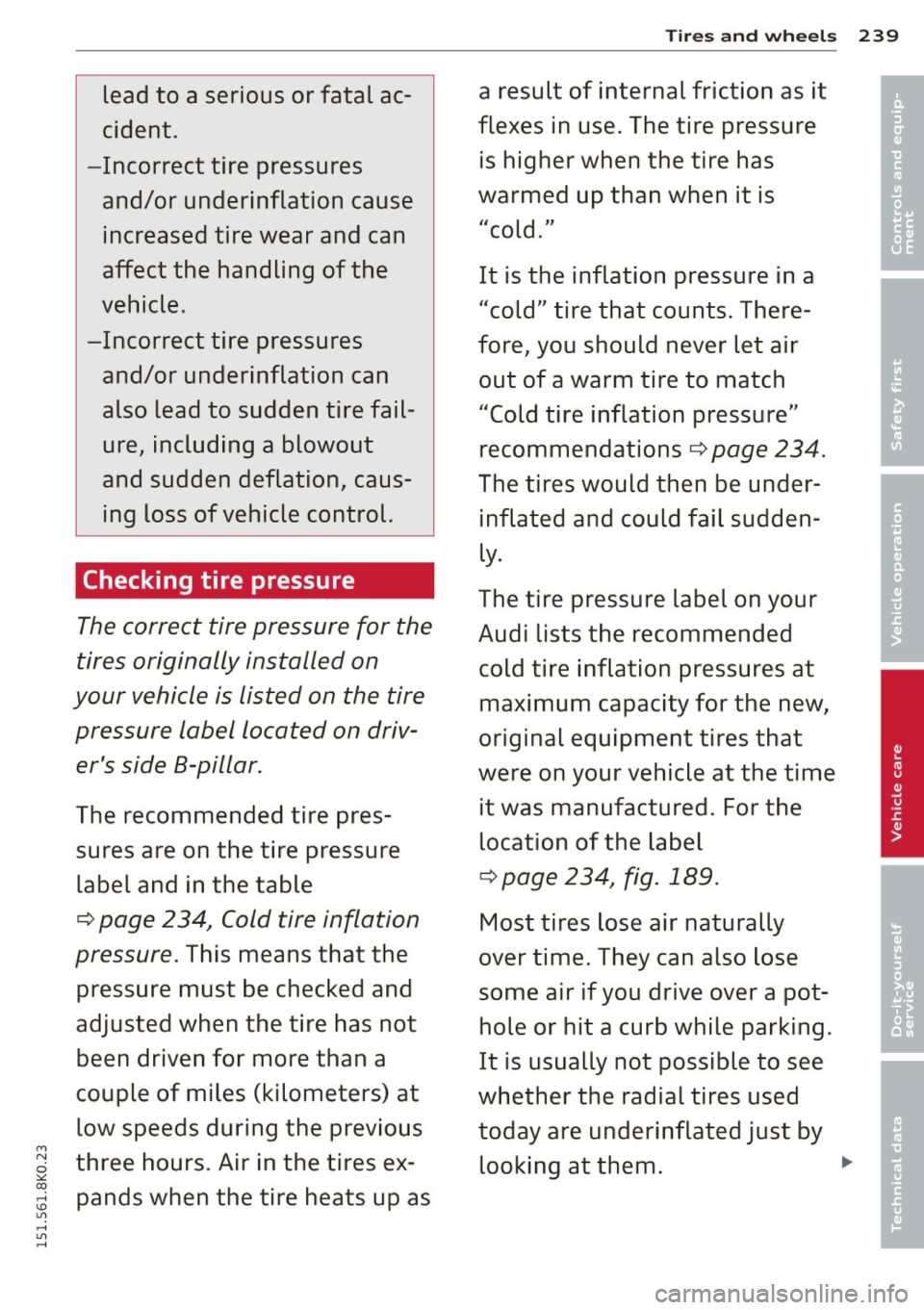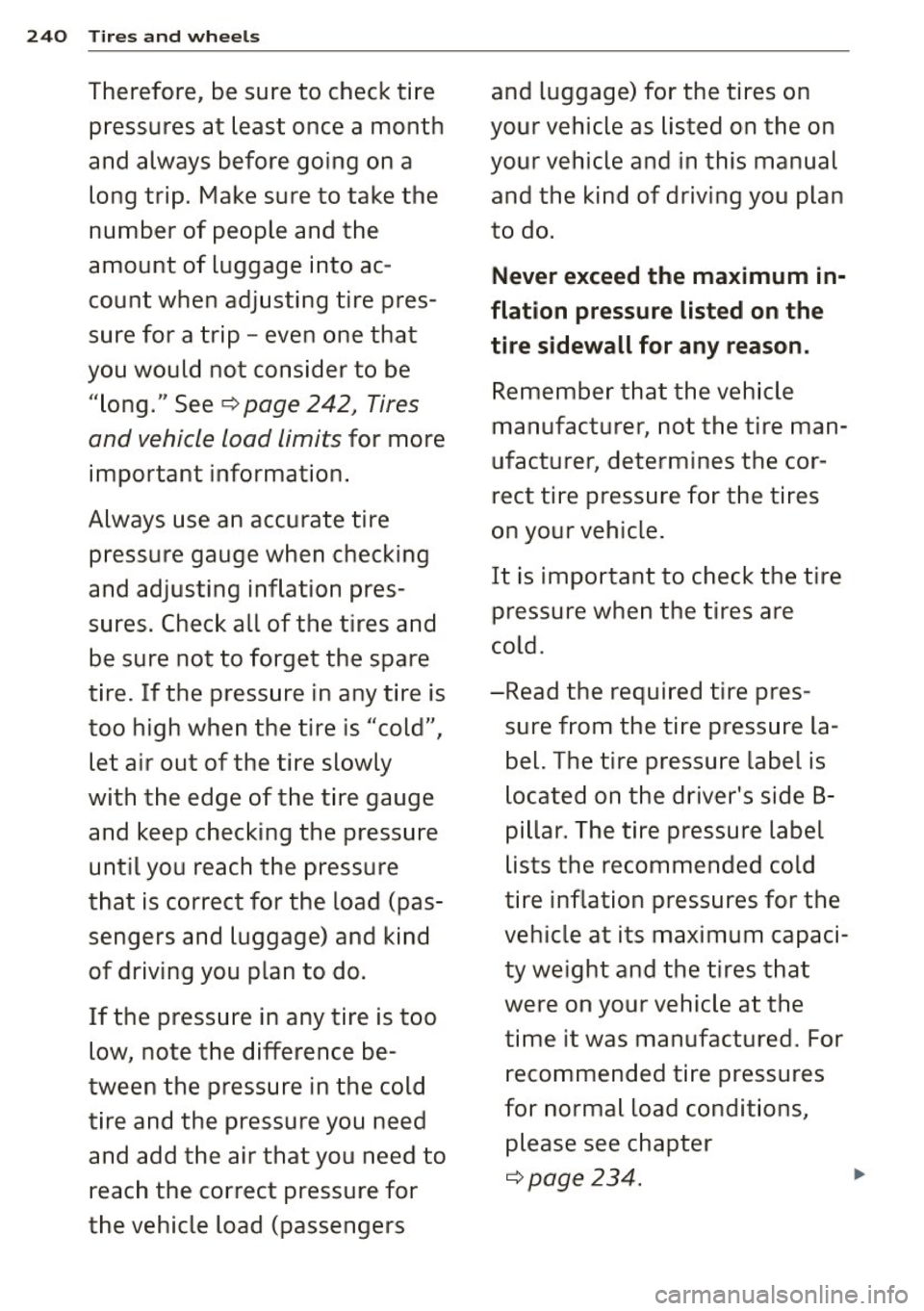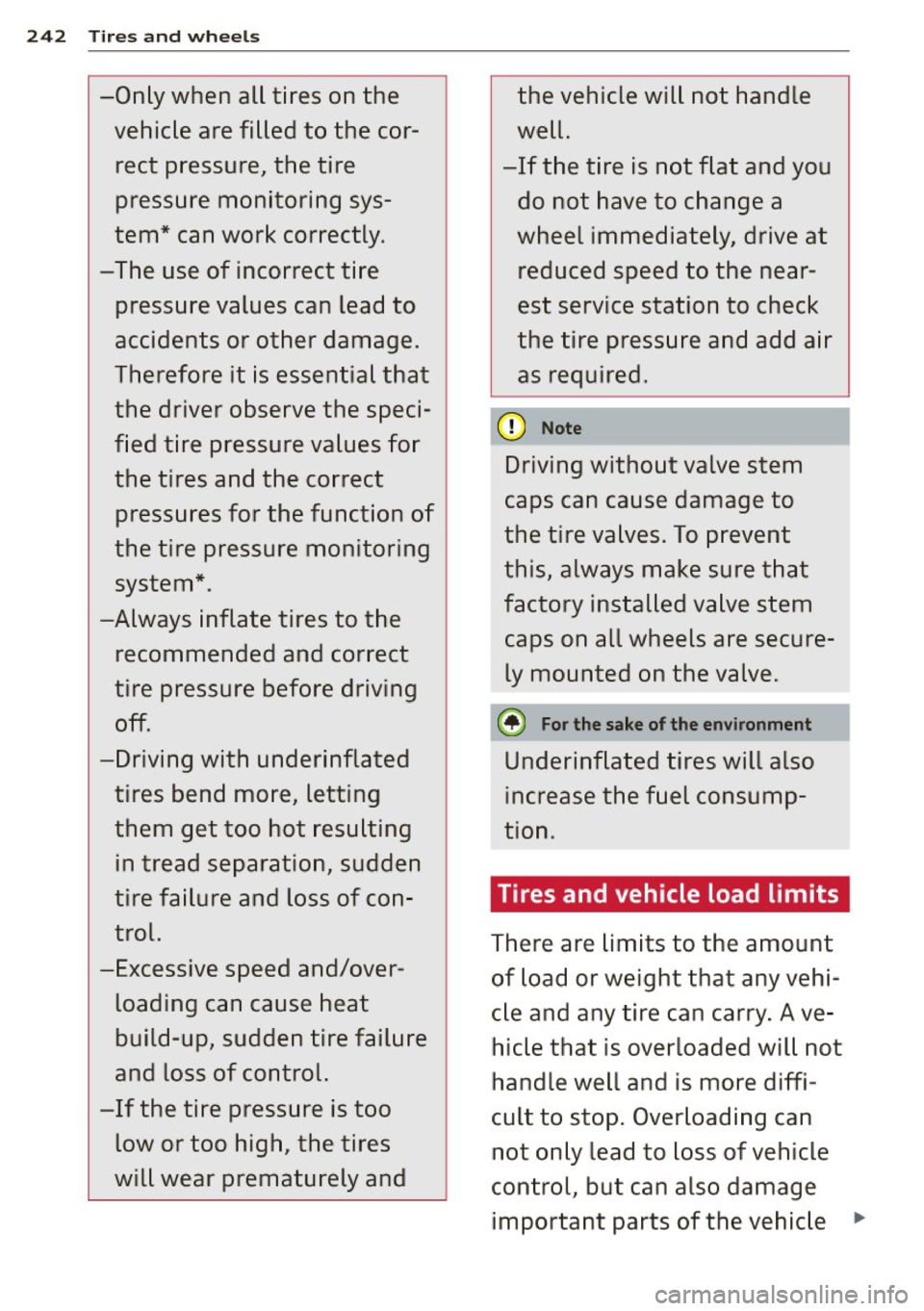2015 AUDI A4 flat tire
[x] Cancel search: flat tirePage 236 of 304

234 Tires a nd whee ls
Vehicle ma ximum load on
the tire
means that load on an individu
al tire that is determ ined by
distr ibuting to each axle its
share of the maximum loaded
vehicle weight and div iding by
two.
Vehicle normal load on the
tire
means that load on an in div id u
al tire that is determ ined by d
istribut ing to each axle its
share of the curb weight, acces
sory weight, and normal occ u
pant weigh t (distributed in ac
cordance with table below
¢ page 234) and dividing by
two .
Occupant loading and distribution for vehicle normal load for
v arious designated seating capac it ies
Designated seating Vehicle normal load, Occupant distribu-
capacity , number of number of occupants tion in a normally
occupants loaded vehicle
5 3 2 in front, 1 in back
seat
Cold tire inflation pressure
Tire pressure affects the overall handling, performance and safety
of a vehicle.
F ig. 1 89 Tire pressure label: located
on driver's side 8 -pillar
~----------~"'
MW OWE lSlllHS P'RES5l0H OES f'Nall A, FIIICJD
:"" -ICPA. • PSI
.::. -KPA.. . PSI
°'~ -KPA. -PSI
Fig. 1 90 Tire pressure label
Page 237 of 304

Tires and wheels 235
Tire pressure generally refers to tant things you can do to help •
the amount of air in a tire that avoid sudden tire failure. Un-• '
it needs it to do its job and derinflated tires are a major
safely carry the combined load cause of sudden tire failure. of the entire vehicle and its con- Keeping tires at the right pres-
tents. Tire pressure is measured sure is also important for safe
in kilopascals (kPa), the inter- and responsive vehicle han-
national measuring unit and in dling, traction, braking and
pounds per square inch (PSI) . load carrying.
Tire pressures
Tire pressure is based in part on are particularly important
the vehicle's design and load when the vehicle is being driv-
limit - the greatest amount of en at higher speeds, and then
weight that the vehicle can car -especially when heavily loaded
ry safely and the tire size. The even within the permissible
proper tire pressure is frequent-load-carrying capacities ap-
ly referred to as the "recom-proved for your vehicle.
mended cold tire inflation pres-The recommended tire pres-
sure ." Air in the tires expands
sures for your Audi depend on
when the tire heats up because the kind of tires on your vehicle
of internal friction when it flex- and the number of passengers
es in use. The tire pressure is and/or amount of luggage you
higher when the tire has will be transporting.
warmed up than when it is The tire pressure label is locat-
"cold. " It is the inflation pres-
ed on the driver's side B-pillar.
sure in a "cold" tire that counts.
Therefore, you should never let The tire pressure label lists the
recommended cold tire infla-
air out of a warm tire to match
"cold tire inflation pressure" tion pressures for the vehicle at
its maximum capacity weight
recommendations. The tires
would then be underinflated and tires that were on your ve
-
and could fail suddenly. hicle at the time it was manu-
'"" factured
. N
0
Maintaining proper tire pres-::.,: co ,...., \!)
sure is one of the most impor-1.1'1 ,...., 1.1'1 ,....,
Page 238 of 304

236 Tires a nd whee ls
If you wish to improve comfort See the illustration ¢ fig. 189
when operating the vehicle at for the location of the label on
normal load (up to 3 occu -driver's side B-pillar (color of
pants), you can adjust tire the actual label and exact loca-
pressures to those specified tion on the vehicle will vary
for normal vehicle load. Before slight ly) .
operat ing the vehicle at maxi -Note that the following table is
mum load, you must increase accurate a t the time of going to
the ti re pressures to those press and is subject to change .
specified for maximum vehicle In the event of discrepancies ,
load¢&. the tire p ressure labe l is locat-
Bear in mind that the tire pres- ed on the driver's side 8-pi llar
sure monitoring system* can a lways takes precedence .
on ly monitor the tire pressures
The table be low lis ts the rec -
you have sto red . The system
ommended cold tire inflation
does not recogn ize t he load
pressures for the Audi model
condition of your vehic le.
covered by your Owner's Li tera-
T he effect iveness of the tire ture at the veh icle's capac ity
p ressure mon itor ing system* weight and the tire sizes instal -
will be impaire d if you st ore led on the respect ive mode ls as
normal load press ures but then original eq uipment, or as a fac -
operate the vehicle at its max i- tory optio n.
...
mum load¢&.
Page 240 of 304

238 Tires and wheels
else or you bought the vehicle
with different rims/tires or you bought the vehicle as a previ
ously owned vehicle.
Remember, your safety and
that of your passengers also de
pends on making sure that load
limits are not exceeded. Vehicle
load includes everybody and ev
erything in and on the vehicle.
These load limits are technical
ly referred to as the vehicle's
Gross Vehicle Weight Rating ("GVWR"). The Gross Axle
Weight Rating ("GAWR") is the maximum load that can be ap
plied at each of the vehicle's
two axles . The Gross Vehicle
Weight Rating and the Gross
Axle Weight Rating are listed
on the safety compliance stick
er label located on the driver's
side B-pillar. The tire pressure
label on your Audi lists the
maximum combined weight of
all of the occupants and lug
gage or other cargo that the ve
h icle can carry . For the location
of the tire pressure label
¢fig . 189.
.&_ WARNI NG -
Overloading a vehicle can
cause loss of vehicle control,
a crash or other accident, se
rious personal injury, and
even death.
-Carrying more weight than
your vehicle was designed to carry will prevent the ve
hicle from handling properly
and increase the risk of a
loss of vehicle control.
-The brakes on a vehicle that
has been overloaded may not be able to stop the vehi
cle with in a safe distance .
-Tires on a vehicle that has been overloaded can fail
suddenly causing loss of
control and a crash.
- Always make sure that the
total load being transported
- including the weight of a
trailer hitch and the tongue
weight of a loaded trailer - does not make the vehicle
heavier than the vehicle's
Gross Vehicle Weight Rating.
.&_ WARNI NG
-Incorrect tire pressures
and/or underinflation can
-
Page 241 of 304

lead to a serious or fatal ac
cident.
- Incorrect tire pressures
and/or underinflation cause increased tire wear and can
affect the handling of the
vehicle .
-Incorrect tire pressures and/or underinflation can
also lead to sudden tire failure, including a blowout
and sudden deflation, caus ing loss of vehicle control.
Checking tire pressure
The correct tire pressure for the
tires originally installed on
your vehicle is listed on the tire pressure label located on driver 's side 8-pillar.
The recommended tire pres
sures are on the tire pressure
label and in the table
c:> page 234, Cold tire inflation
pressure.
This means that the
pressure must be checked and
adjusted when the tire has not
been driven for more than a
couple of miles (kilometers) at
low speeds during the previous
three hours. Air in the tires ex pands when the tire heats up as
Tires and wheels 239
a result of internal friction as it
flexes in use. The tire pressure is higher when the tire has
warmed up than when it is " ld ,, co .
It is the inflation pressure in a
"cold" tire that counts. There
fore, you should never let air
out of a warm tire to match
"Cold tire inflation pressure" recommendations
c:> page 234.
The tires would then be under inflated and could fail sudden
ly.
The tire pressure label on your
Audi lists the recommended cold tire inflation pressures at maximum capacity for the new,
original equipment tires that
were on your vehicle at the time it was manufactured. For the
location of the label
c:> page 234, fig. 189.
Most tires lose air naturally
over time. They can also lose
some air if you drive over a pot hole or hit a curb while parking.
It is usually not possible to see
whether the radial tires used
today are underinflated just by looking at them.
•
•
'
Page 242 of 304

240 Tires and wheels
Therefore, be sure to check tire and luggage) for the tires on
pressures at least once a month your vehicle as listed on the on
and always before going on a your vehicle and in this manual
long trip. Make sure to take the and the kind of driving you plan
number of people and the to do.
amount of luggage into ac-
Never exceed the maximum in-
count when adjusting tire pres-flation pressure listed on the
sure for a trip -even one that tire sidewall for any reason.
you would not consider to be
Remember that the vehicle
" long ." See
¢ page 242, Tires
manufacturer, not the tire man-and vehicle load limits for more
important information. ufacturer, determines the cor-
rect tire pressure for the tires
Always use an accurate tire on your vehicle.
pressure gauge when checking It is important to check the tire
and adjusting inflation pres-
pressure when the tires are
sures. Check all of the tires and
be sure not to forget the spare cold
.
tire. If the pressure in any tire is -Read the
required tire pres-
too high when the tire is "cold", sure from the tire pressure
la-
let air out of the tire slowly bel.
The tire pressure label is
with the edge of the tire gauge located
on the driver's side B-
and keep checking the pressure pillar. The tire pressure label
until you reach the pressure lists the recommended cold
that is correct for the load (pas- tire inflation
pressures for the
sengers and luggage) and kind vehicle at its maximum capaci-
of driving you plan to do. ty weight and the tires that
If the pressure in any tire is too were on your
vehicle at the
time it was manufactured. For
low, note the difference be-
tween the pressure in the cold recommended
tire pressures
for normal load conditions,
tire and the pressure you need
please see chapter
and add the air that you need to
¢page 234. ...
reach the correct pressure for
the vehicle load (passengers
Page 243 of 304

Tires and wheels 241
-Turn the valve stem cap coun- ize the new tire pressures in the •
ter-clockwise to remove it tire pressure monitoring sys-• '
from the tire valve. tern*
¢ page 257.
-Place the air pressure gauge
A WARNING
on the valve.
Incorrect tire pressures and/
-The tire pressures should only or underinflation can lead
be checked and adjusted when sudden tire failure, loss of
the tires are cold. The slightly control, collision, serious per-
raised pressures of warm tires sonal injury or even death.
must not be reduced. -When the
ti] warning sym-
-Adjust the tire pressure to the bol appears in the instru-
load you are carrying. ment cluster, stop and in-
-Reinstall the valve stem cap spect the tires.
on the valve. -Incorrect tire pressure and/
When should I check the tire or underinflation can cause
pressure? increased tire wear and can
The correct tire pressure is es- affect the handling of the
pecially important at high vehicle and stopping ability.
speeds. The pressure should -Incorrect tire pressures
therefore be checked at least and/or underinflation can
once a month and always be- also lead to sudden tire fail-
fore start ing a journey. Do not ure, including a blowout
forget to check the tire pres- and sudden deflation, caus-
sure for the spare wheel. ing loss of vehicle control.
When should I adjust the
-
The driver is responsible for
the correct tire pressures for
tire pressures?
all tires on the vehicle. The
Adjust the tire pressure to the applicable pressure values
load you are carrying. After are located on a sticker on
changing a wheel
or replacing the driver's side B-pillar.
wheels you have to adjust the
'"" N
0 tire pressures on all wheels. In ::.,: co ....
addition, you must then initial-\!) 1.1'1
.... 1.1'1 ....
Page 244 of 304

242 Tires and wheels
-Only when all tires on the
vehicle are filled to the cor rect pressure, the tire
pressure monitoring sys
tem* can work correctly.
-The use of incorrect tire
pressure values can lead to
accidents or other damage.
Therefore it is essential that
the driver observe the speci
fied tire pressure values for
the tires and the correct pressures for the function of
the tire pressure monitoring
system*.
-Always inflate tires to the
recommended and correct
tire pressure before driving off.
-Driving with underinflated
tires bend more, letting
them get too hot resulting
in tread separation, sudden
tire failure and loss of con
trol.
-Excessive speed and/over
loading can cause heat
build-up, sudden tire failure
and loss of control.
-If the tire pressure is too
low or too high, the tires
will wear prematurely and the vehicle will not handle
well.
-If the tire is not flat and you
do not have to change a
wheel immediately, drive at
reduced speed to the near
est service station to check
the tire pressure and add air
as required.
(D Note
Driving without valve stem
caps can cause damage to
the tire valves. To prevent
this, always make sure that
factory installed valve stem
caps on all wheels are secure
ly mounted on the valve.
@ For the sake of the environment
Underinflated tires will also
increase the fuel consump
tion.
Tires and vehicle load limits
There are limits to the amount
of load or weight that any vehi
cle and any tire can carry. Ave
hicle that is overloaded will not
handle well and is more diffi
cult to stop. Overloading can not only lead to loss of vehicle
control, but can also damage
important parts of the vehicle
...